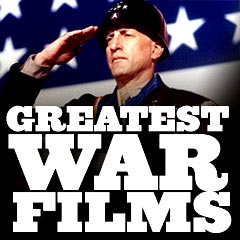
|
Greatest War Movies 1950s |
| Film Title/Year/Director, War-time Setting and Brief Description | ||

|
Top stars Humphrey Bogart (in an Oscar-winning performance as cynical, alcoholic boat owner Charlie Allnut) and Katharine Hepburn (as stubborn, indomitable spinster missionary Rose Sayer) appeared together in John Huston's exciting World War I adventure film, shot on location in Africa. Together, as representatives of the American and British positions, they confronted the Germans on the geographical margins of the major conflict. During the course of many hardships and quarrels along a course filled with tropical dangers and 'evil' Germans in a warship, they developed a hard-earned love and respect for each other. The real prize and goal of their water journey down the Ulonga-Bora, other than the destruction of a German boat, was to overcome the various psychological obstacles that stood between them. |
 
|

|
The Desert Fox (1951) (aka The Story of Rommel)
James Mason starred in this sympathetic, war-related biopic as skilled war tactician German Field Marshal Erwin Rommel ("The Desert Fox"), the famed tank commander in war-torn North Africa who was ultimately involved in a plot to kill Hitler that led to his own death. The story was narrated by Colonel Desmond Young (who played himself, but whose voice was provided in the narration by actor Michael Rennie), who wrote the book of the same name - adapted for the screen by Nunnally Johnson. Two years later, Mason reprised his character role in The Desert Rats (1953). |
 
|

|
The Desert Rats (1953)
This 'sequel' to the 1951 film (see above), also starring James Mason as Rommel (in a cameo), was another brilliant character study. Its most memorable moment was the confrontation scene in a German field hospital tent between Rommel and harsh Scottish officer Captain Tammy MacRoberts (Richard Burton in his second film), who was assigned to command the Australian 9th Division ("The Rats of Tobruk") valiantly defending the desert port stronghold of Tobruk against Rommel's takeover of the Suez Canal. MacRoberts challenged: "If you can crush Tobruk, then crush it!" |
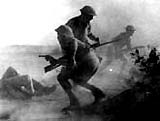
|

|
From Here to Eternity (1953)
This film provided a realistic portrayal of the demands of career military life just before US involvement in WWII. It told the powerful, realistic story (and fierce indictment) of the lives of American military men (and their women) stationed in peacetime Hawaii (near Honolulu) in the summer and fall before the surprise attack on Pearl Harbor in late 1941 and the US entrance into WW II. It was a multi-awarded, Best Picture-winning film, based on James Jones' novel. It starred Burt Lancaster as tough Sergeant Milton Warden, Montgomery Clift as bugler/private Robert E. Lee Prewitt, Deborah Kerr as Commander Holmes' unfulfilled wife Karen, and Donna Reed as local "hostess" prostitute Lorene. |

|
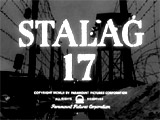
|
Stalag 17 (1953)
Billy Wilder's black comedy examined a group of G.I.s (including Best Actor-winning William Holden as self-interested, deal-making POW Sgt. J.J. Sefton) who were thrown together in the notorious German WWII prison camp, Stalag 17, commanded by cruel Oberst von Scherbach (Otto Preminger). The film's tension centered around the POW's suspicion that Sefton was a "stoolie," after which they beat him and ostracized him. However, Sefton began to uncover the real German spy's identity while on his bunk and under the shadow of a naked hanging lightbulb (serving as a signal - with a knot or loop in the cord) - the villain was later revealed to be barracks security officer Price (Peter Graves). |
 
|

|
The Bridges at Toko-Ri (1954)
In Mark Robson's film (an Oscar-winner for Best Special Effects), an adaptation based on James Michener's best-selling novel about heroic civic responsibility, William Holden played the role of war-weary veteran Lieutenant Harry Brubaker - a family man who was a WWII Navy fighter pilot recalled from the Naval Reserve to fly a possibly-fateful bombing mission over indestructible, heavily-fortified, Communist-protected bridges in Korea - the Bridges at Toko-Ri. A civilian lawyer, Harry complained about being recalled to duty after serving in World War II and questioned why America was fighting in Korea. The mission would threaten to endanger his domestic life with loving pretty wife Nancy (Grace Kelly) and their two children, although he felt obligated to complete it. The mission was successfully executed amidst heavy enemy fire, as the bombers blew up all the bridges, but continued on to hit secondary targets. The film, shot on location, ended with his death after being shot down and crash-landing in enemy territory, with the thought-provoking quote at its conclusion: "Where do we get such men?" |
  
|

|
To Hell and Back (1955)
Texan farm youth, decorated military hero and brave Medal of Honor winner Audie Murphy starred in this Hollywoodized autobiographical film (based on his 1949 book) about his war-time experiences in the 3rd Infantry Division in S. France and Italy. Technicolor and CinemaScope enhanced the battle vistas. The war film popularized the term for U.S. Army foot soldiers -- dogfaces. He singlehandedly fired upon German forces, in the film's conclusion, atop a burning tank - earning the Medal of Honor. The film followed Murphy's platoon on the beaches in Sicily, and their engagements with Nazis defending a strategic Italian farmhouse, and at Volturno and other locations on the way to Rome. They also met desperate resistance as the retreating enemy fought them when leaving France toward Germany. |
  
|

|
John Ford's western film's complex, deeply-nuanced themes included racism, individuality, the American character, and the opposition between civilization (exemplified by homes, caves, and other domestic interiors) and the untamed frontier wilderness. It told the emotionally complex story of a perilous, hate-ridden quest and Homeric-style odyssey of self-discovery by Ethan Edwards (John Wayne) after a Comanche massacre, while also exploring the themes of racial prejudice and sexism. Its meandering tale examined the inner psychological turmoil of a fiercely independent, crusading man obsessed with revenge and hatred. |

|
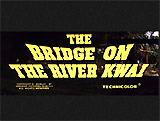
|
David Lean's acclaimed, all-time great, award-winning, widescreen WWII epic drama was about British P.O.W.s forced to construct a railway bridge in the Asian jungle of Burma, for the Burma-Siam railway. The powerful film was a perceptive character study based on an outstanding, psychologically complex adaptation of Pierre Boulle's 1952 novel. Its main focus was the 'madness' of war - exemplified by the clash of wills between two fanatical military leaders. British prisoner/solders, led by an obstinate commander Col. Nicholson (Alec Guinness), constructed a rail bridge - and unwittingly aid the war effort of their Japanese captors and the camp commander Col. Saito (Sessue Hayakawa). A tremendously antagonistic battle of wills ensued between the two Colonels. Nicholson supervised the bridge's construction with a twisted sense of pride in his creation to show up the Japanese as inferior. In the climactic finale, British and American intelligence officers (William Holden, Jack Hawkins) conspired to successfully blow up the structure. |
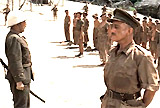 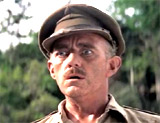 
|

|
Stanley Kubrick's classic, effective, powerfully bleak, anti-war drama on the hypocrisy of battle, was based on Humphrey Cobb's factual novel. The film was an effective denouncement of self-seeking, pitiless WWI French military leaders whose strategy and mishandling of a failed mission were incomprehensible. During horrendous trench warfare on the French front (filmed with realistic tracking shots), a vain and pompous French General Mireau (George Macready) ordered his hapless group of soldiers to suicidally attack an obviously-impenetrable German stronghold, the "Anthill." When they predictably failed in the ill-conceived attack, he angrily commanded his own artillery to fire on the 'cowardly' troops. Further, he arbitrarily picked three blameless men as scapegoats - at random - to stand trial and wrongfully be court-martialed for cowardice - and face execution by firing squad. Infantry commander and dissenting Army lawyer Colonel Dax (Kirk Douglas), the commander of the French regiment stationed along the Western Front, aware of the disgraceful cover-up and episode, unsuccessfully defended the condemned men. Its WWI warfare scenes, with technically-brilliant tracking shots in the trenches, remain some of the most realistic ever filmed. |
  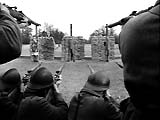
|

|
Dunkirk (1958, UK)
This uncompromising Ealing Studio film, one of the last B/W British films about WWII in the 1950s, combined Elleston Trevor's novel The Big Pickup with a factual account named Dunkirk by Ewan Butler and J.S. Bradford. John Mills starred as easy-going Cpl. "Tubby" Binns, a British corporal in France, who was reluctantly appointed to lead his detached group of defeated men to Dunkirk where they would retreat back to Britain across the English Channel - a significant moment in the war. A large portion of the last 30 minutes of the film - the actual evacuation - used newsreel footage. |
  |

|
Run Silent, Run Deep (1958)
Robert Wise's war film, the best WWII submarine-related movie, was based on the 1955 novel by naval submariner Edward Beach, loosely using the themes and structure of Melville's Moby Dick. It starred Burt Lancaster as Lieut. Jim Bledsoe and Clark Gable as martinet Commander P.J. "Rich" Richardson - two clashing US Navy submarine officers onboard the USS Nerka struggling for leadership. Richardson was intensely obsessed and determined to sink the Japanese destroyer in the Bungo Straits, the Akakaze, known to the sub crews as "Bungo Pete" that had sunk his previous submarine, and was thus seeking revenge - and endangering the crew in his self-imposed mission. |
  |

|
Ballad of a Soldier (1959,
Soviet Union) (aka Баллада о солдате or
Ballada O Soldate)
This original, life-affirming and charming Soviet film set during WWII told about a young 19 year-old grunt infantryman soldier, Pvt. Alyosha Skvortsov (Vladimir Ivashov), who was awarded a medal for heroism, and then granted a week's leave from the Eastern Front to visit his mother. [The film commenced by revealing that Alyosha was later killed during battle, never to see his mother or love-interest Shura again.] During his journey home through the war-torn land, he met shy young Shura (Zhanna Prokhorenko) on a freight train and fell in love, and was only briefly united with his mother for a simple hug in a wheat field. Devoid of typical war footage, this emotional love story was a poignant tale of war-time romance. |

|
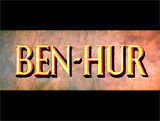
|
MGM's three and a half hour, wide-screen epic Technicolor blockbuster was a Biblical tale, subtitled A Tale of the Christ. In the Best Picture-winning plot, prince Judah Ben-Hur (Charlton Heston) was enslaved by Roman tribunal friend Messala (Stephen Boyd) (with a homosexual subtext provided by co-writer Gore Vidal), but then returned years later, after an exciting slave galley ship battle in which he saved Roman Quintus Arrius (Jack Hawkins), to seek revenge in the film's centerpiece, a chariot race. |
  
|

|
Pork Chop Hill (1959)
Lewis Milestone's anti-war masterpiece about the futility of "police action" warfare starred Gregory Peck as Army Lieutenant Joe Clemons of a platoon (King Company, 7th Infantry) in a no-win situation. The military group was commanded to assault a tactically-unimportant, but well-guarded hill held by the N. Koreans and Chinese Communists in the final days of the war. The documentary-styled film was based on the historical battle account titled Pork Chop Hill: The American Fighting Man in Action, Korea, Spring 1953, written by S.L.A. Marshall. |
 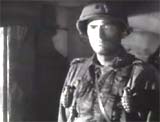
|
(chronological by film title) Introduction | 1900s-1920s | 1930s | 1940s-1 | 1940s-2 | 1950s | 1960s-1 | 1960s-2 | 1970s | 1980s | 1990s | 2000s | 2010s |